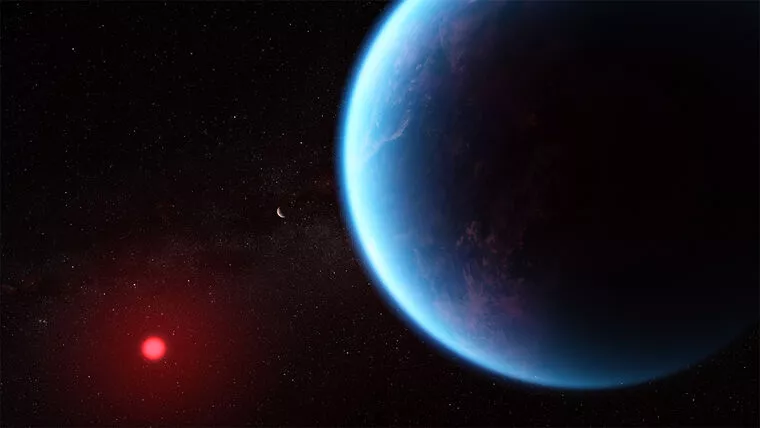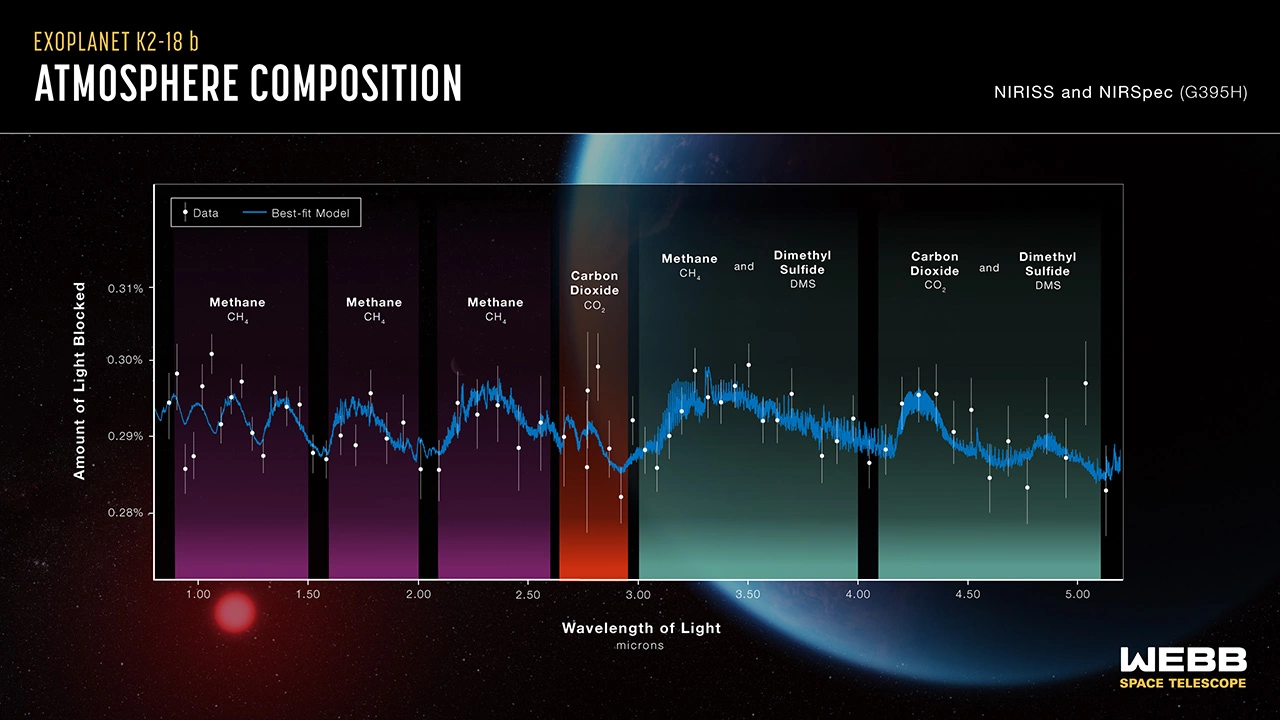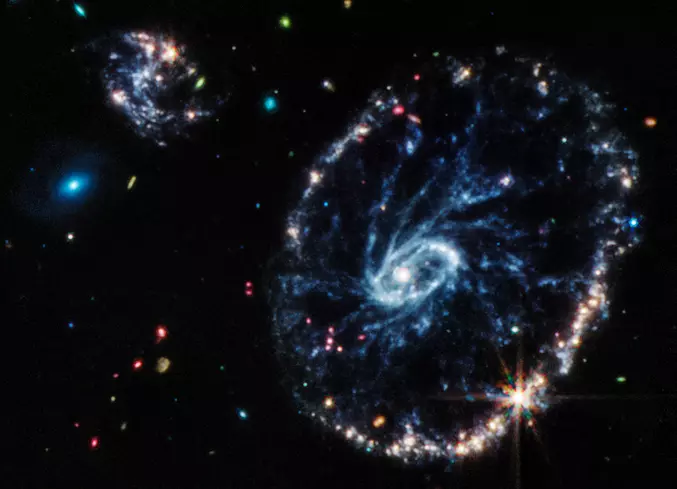In a groundbreaking discovery, NASA’s James Webb Space Telescope may have just spotted signs of extraterrestrial life on a faraway exoplanet 8.6 times as massive as Earth, dubbed K2-18b.
In a study accepted for publication in The Astrophysical Journal Letters, researchers said James Webb detected a molecule called dimethyl sulfide (DMS), which is exclusively produced by living organisms on Earth. Along with DMS, researchers also detected the presence of carbon-bearing molecules, including methane and carbon dioxide, in the exoplanet’s atmosphere.
According to NASA, the presence of these gasses suggests K2-18b could be a Hycean exoplanet, potentially possessing a hydrogen-rich atmosphere and ocean-covered surface, significantly boosting its odds of hosting life.
More data is needed to confirm the findings. However, researchers said they were “shocked” by the initial results and the possibility that K2-18b might offer the first confirmation of extraterrestrial life.
“On Earth, DMS is only produced by life. The bulk of it in Earth’s atmosphere is emitted from phytoplankton in marine environments,” lead study author and University of Cambridge professor Dr. Nikku Madhusudhan told the BBC.
“If confirmed, it would be a huge deal, and I feel a responsibility to get this right if we are making such a big claim.”
Positioned 120 light-years away in the constellation Leo, K2-18b orbits a cool dwarf named K2-18 within what is known as the habitable zone. With a size falling between Earth and Neptune, what scientists call a “sub-Neptune” type world, K2-18b defies any comparison with planets in our solar system.
“Although this kind of planet does not exist in our solar system, sub-Neptunes are the most common type of planet known so far in the galaxy,” research team member Dr. Subhajit Sarkar of Cardiff University explained in a NASA press release.
The absence of similar planets within our solar system means sub-Neptunes, like K2-18b, are poorly understood, and the composition of these planet’s atmospheres is a hot topic of discussion among astronomers. Nevertheless, given the abundance of sub-Neptune bodies in the universe, some astronomers believe these giant exoplanets could be promising targets in the search for extraterrestrial life.
“Our findings underscore the importance of considering diverse habitable environments in the search for life elsewhere,” Dr. Madhusudhan explained. “Traditionally, the search for life on exoplanets has focused primarily on smaller rocky planets, but the larger Hycean worlds are significantly more conducive to atmospheric observations.”
Many scientists have begun increasingly echoing Dr. Madhusudhan’s sentiments on considering the diverse ways extraterrestrial life might exist.
Recently, The Debrief reported on a theory proposed by astrobiologist Dr. Dirk Schulze-Makuch that NASA’s historic Viking missions in the 1970s actually found—and inadvertently exterminated—extraterrestrial life on Mars.
According to Dr. Schulze-Makuch, by introducing Earth-like conditions in the experiments conducted by Viking’s landers, scientists may have missed the evidence or, worse yet, unintentionally exterminated Martian microbes that had adapted to the planet’s dry climate.


Researchers say this potentially momentous discovery of alien life on K2-18b was only possible thanks to the James Webb Space Telescope’s remarkable ability to analyze light passing through an exoplanet’s atmosphere and decode its chemical composition by splitting it into constituent frequencies.
First launched in December 2021, the James Webb Space Telescope represents a monumental advance in sensitivity and resolution compared to its infrared telescope predecessors. According to a research paper published in The Astrophysical Journal Letters in 2022, early observations from the telescope have experts predicting that its contributions will be “transformational” for both astrophysics and our grasp of the universe.
“This result was only possible because of the extended wavelength range and unprecedented sensitivity of Webb, which enabled robust detection of spectral features with just two transits,” said Madhusudhan. “For comparison, one transit observation with Webb provided comparable precision to eight observations with Hubble conducted over a few years and in a relatively narrow wavelength range.”


Researchers are treating this initial data supporting the presence of life on K2-18b with caution. A similar claim made in 2020 about the existence of phosphine on Venus was later disputed.
The research team has plans to continue their investigation of K2-18b using James Webb’s MIRI (Mid-Infrared Instrument) spectrograph. They aim to reinforce the validity of their initial discoveries while gaining deeper insights into the environmental characteristics of the distant world. They hope to confirm these initial chemical signatures of life within the following year.
“Upcoming Webb observations should be able to confirm if DMS is indeed present in the atmosphere of K2-18 b at significant levels,” Dr. Madhusudhan explained.
Whether or not the findings are ultimately confirmed, scientists emphasize that the preliminary data showcases the James Webb Space Telescope’s potent capabilities for uncovering potential signs of extraterrestrial life in far-off corners of the universe.
“We are slowly moving towards the point where we will be able to answer that big question as to whether we are alone in the Universe or not,” Deputy Director of the Royal Astronomical Society in London, Dr Robert Massey, told the BBC.
“I’m optimistic that we will one day find signs of life. Perhaps it will be this. Perhaps in 10 or even 50 years, we will have evidence that is so compelling that it is the best explanation.”
Tim McMillan is a retired law enforcement executive, investigative reporter and co-founder of The Debrief. His writing typically focuses on defense, national security, the Intelligence Community and topics related to psychology. You can follow Tim on Twitter: @LtTimMcMillan. Tim can be reached by email: tim@thedebrief.org or through encrypted email: LtTimMcMillan@protonmail.com

